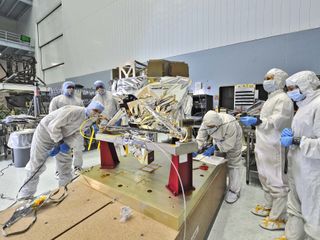NASA's Next Big Space Telescope Gets 1st Delivery

The first instrument for NASA's next flagship space observatory, the James Webb Space Telescope, has arrived.
The telescope's Mid-Infrared Instrument (MIRI), which will help astronomers see cold, distant objects in unprecedented detail, was delivered to NASA's Goddard Space Flight Center in Greenbelt, Md., and is currently undergoing a series of systems tests. It is the first of four main instruments that be attached to the James Webb Space Telescope.
The next-generation space telescope is being billed as the successor to the prolific Hubble Space Telescope. The $8.8 billion observatory is slated to launch in 2018.
The Webb telescope's powerful instruments are expected to help astronomers piece together how the universe evolved from the Big Bang, and how our solar system was formed.
MIRI was assembled and shipped from the Science and Technology Facilities Council's Rutherford Appleton Laboratory in the United Kingdom. The instrument was jointly developed by 10 European institutions and NASA's Jet Propulsion Laboratory in Pasadena, Calif.
"MIRI is the first Webb instrument to be delivered, the result of teamwork in the U.S. and internationally," George Rieke, leader of the MIRI science team at the University of Arizona in Tucson, said in a statement. The instrument was delivered to Goddard on May 29, though NASA officials announced its arrival in mid-June.
Officials at Goddard will inspect MIRI before installing it in the James Webb Space Telescope's science instrument payload, which is officially called the Integrated Science Instrument Module, or ISIM. [Photos: Building the James Webb Space Telescope]
Get the Space.com Newsletter
Breaking space news, the latest updates on rocket launches, skywatching events and more!
MIRI will inspect cosmic light in wavelengths in the mid-infrared range, which is longer than what the human eye can see.
"MIRI will enable Webb to distinguish the oldest galaxies from more evolved objects that have undergone several cycles of star birth and death," Matt Greenhouse, ISIM project scientist at Goddard, said in a statement. "MIRI also will provide a unique window into the birth places of stars which are typically enshrouded by dust that shorter wavelength light cannot penetrate."
The instrument's detectors will be so sensitive they will be able to glimpse light, cool stars in very distant galaxies, NASA officials said. MIRI is also expected to witness star formation in our Milky Way galaxy, find evidence of planets forming around other stars, and snap images and collect data on planets, comets and pieces of cosmic debris at the far reaches of our solar system.
"MIRI will help us understand what's out there at the edge of what we can see," said Mike Ressler, project scientist for the MIRI instrument at the Jet Propulsion Laboratory. "The shorter-wavelength instruments will discover the glow of the farthest known objects, but we need MIRI to help identify what they are — supermassive black holes, newborn galaxies or something we've never seen before."
The James Webb Space Telescope is a joint project between NASA, the European Space Agency and the Canadian Space Agency.
Follow SPACE.com on Twitter @Spacedotcom. We're also on Facebook and Google+.
Join our Space Forums to keep talking space on the latest missions, night sky and more! And if you have a news tip, correction or comment, let us know at: community@space.com.

Space.com is the premier source of space exploration, innovation and astronomy news, chronicling (and celebrating) humanity's ongoing expansion across the final frontier. Originally founded in 1999, Space.com is, and always has been, the passion of writers and editors who are space fans and also trained journalists. Our current news team consists of Editor-in-Chief Tariq Malik; Editor Hanneke Weitering, Senior Space Writer Mike Wall; Senior Writer Meghan Bartels; Senior Writer Chelsea Gohd, Senior Writer Tereza Pultarova and Staff Writer Alexander Cox, focusing on e-commerce. Senior Producer Steve Spaleta oversees our space videos, with Diana Whitcroft as our Social Media Editor.
Most Popular

